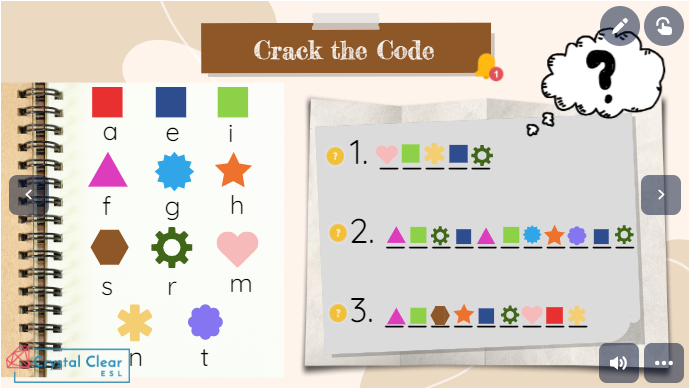Level Up Your Teaching with Gamification!
Gone are the days of monotonous drilling and memorisation! Gamification is taking over the online ESL classroom!
If you’re familiar with the Crystal Clear curriculum, you’ll know that we’ve packed our lessons full of fun, interactive games to support your students’ learning adventures. Online classroom games offer numerous advantages to students at all academic levels, regardless of age. Not only do games support language acquisition, but they make learning a memorable experience that fosters a lifelong love for learning.
The term ‘gamification’ can be described as the application of typical game-playing elements and design techniques to other areas of activity. With technological developments in education, games are now easier than ever to implement in your online classroom. Gamification harnesses elements like point scoring, rewards, and rules of play to motivate learners to accomplish tasks typically viewed as boring or tedious, like learning.

Games make learning fun- and improve retention!
The most obvious benefit of playing games in the online classroom is that it makes learning fun and encourages engagement. ‘Games provide learners with opportunities to practice their language skills in a fun and interactive way, which can help them retain the language better’ (Kapp, 2012). But gamification is more than just fun and games! Gameplay can develop and improve cognitive abilities as well as critical thinking.
Games create a sense of freedom and provide a low-risk, high-reward environment that encourages students to experiment with new language concepts and build confidence. Games can make learning an enjoyable experience for students (and teachers!) and ignite enthusiasm to come to class and participate. Your ESL students will often be taking English lessons after a long day of school or work. Games bring much-needed excitement to a classroom and can help refocus students when they are weary from a long day, have just returned from a learning break, or have any other distraction that might negatively impact their focus in class.
Games reduce anxiety
Many ESL students hail from countries rife with test culture, where learning is serious business, and failure often results in punishment. The performance pressure placed on students can result in a negative attitude towards learning, low self-esteem, and lack of confidence; none of which are ingredients in the recipe for your student’s success. Games provide relief from the pressures of academic excellence without compromising on learning. Games allow you to adopt a gentler, more compassionate approach in the virtual classroom, which coaches students in a way that cultivates curiosity, experiential learning, and confidence!
Games motivate students to learn
Gamification can intrinsically motivate your students by tapping into universal human motivators like achievement, autonomy, pleasure, self-esteem, and security. Although the hierarchy of importance of these motivators will vary between individuals, we consider these motivators universal because they exist across cultures and all ages.
Games can intrinsically motivate your students, especially young learners. Young learners are usually not motivated to learn English by the lure of being more adept in social settings, landing a job, or going to university. Young learners are learning English because their parents want them to, and it’s rare to find an exception to this. Intrinsically motivate students through gamified classroom experiences to encourage them to view learning a new language as something they want to do rather than something they need to do. ‘Gamification can increase learners’ engagement and motivation, which can lead to better learning outcomes’ (Zichermann & Cunningham, 2011).
The result? Your job as a teacher becomes that much more gratifying, and mastering the English language becomes that much more rewarding for your students!

Games are adaptable and use multiple intelligences
In the online classroom, games are more than just frivolous fun; games should always have a purpose and support your students’ immediate and long-term learning objectives. Games often test multiple intelligences and can be adapted to support a student’s learning preference. Games involving problem-solving and puzzles may delight analytical learners, while games incorporating songs, videos, and movement can support kinesthetic, visual, and auditory learners. Teachers can create games that use all four language skills and modify them to meet their students’ learning preferences, needs, and goals. Games lend themselves to extensions and allow teachers to expand on lessons for more advanced learners or simplify concepts for lower proficiencies. Games can include music, movement, and touch, which add an extra sensory element to your lessons.



Games provide real-world context
A lack of real-world simulations to practice a new language can be a colossal hurdle for students to overcome and can impede their advancement in language acquisition. But games help bring learning to life! Games in the classroom often harness a communicative approach to learning that can prepare students for real-life situations. Gameplay equips students with the eloquence they need to shine in social settings and the knowledge they need to excel in academics. Games, like role-playing, simulate real-world situations that provide students with a context for learning and first-hand experience of the relevance and application of English in the real world.



Games encourage collaboration and social skills
Games can be a powerful tool for managing classrooms, particularly in group settings, and can build collaboration, teamwork, cooperation, and social skills. As a double-whammy benefit, games played in group lessons can contribute towards social-emotional learning (SEL), which includes communication, empathy, and self-worth.
What’s more, games are not limited to the screen! Games can be played in the virtual classroom with realia and be used for homework tasks, like a ‘show and tell’ activity or a garden scavenger hunt! When it comes to gameplay in the online classroom, your and your students’ creativity and imagination is the limit!
Ready to roll the dice and LEVEL UP your lesson delivery?
We’ve launched a BRAND NEW GAME-CHANGING membership that gives you the magic of a gamified classroom right at your fingertips! ????
The Crystal Clear collection of customisable game templates can be adapted to suit ANY learning object and can be used with ANY ESL curriculum – not just Crystal Clear’s!
At a pocket-friendly monthly price, you gain exclusive access to a treasure chest of 30+ customisable review templates, practise activities, brain breaks, and warm-ups!
Our customisable games are bound to make you the COOLEST teacher in the classroom AND save you even more time on lesson prep! ????
JOIN the Customisable Games Membership
✨ If you want to discover some more ESL games, our friends at Twinkl have a Games section featured on their ESL curriculum homepage! ✨







